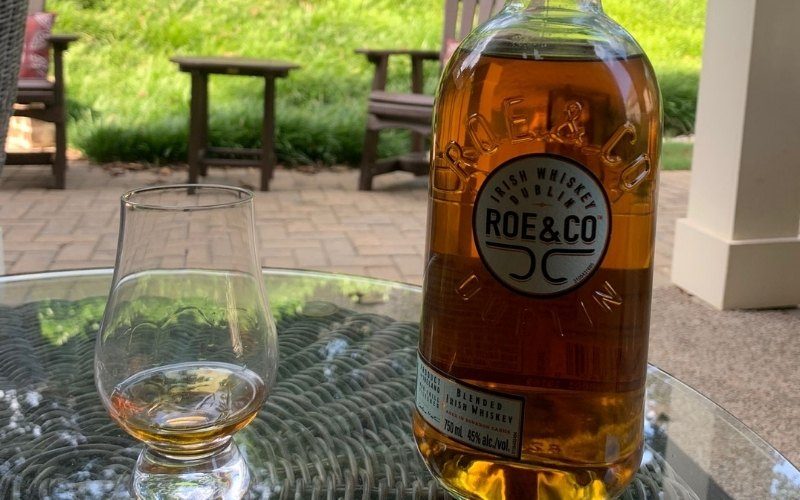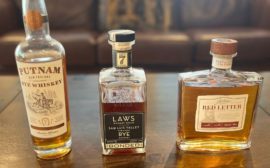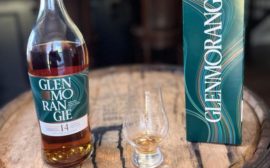Whisky: Roe & Co
Producer: Diageo
Whisky Type: Irish Blend (A blend of malted barley from Bushmills and grain whiskey)
Age: Non-Age Statement (NAS)
Region: Dublin
ABV: 45% Non-Chill Filtered
Aged in Cask: Bourbon casks (a great portion of first fill)
Price Range: $
Roe & Co is located in James’ Street in the Liberties, Dublin, Ireland. Roe & Coe Irish whiskey is a contemporary blend that honors the memory of George Roe, a whiskey maker whose distillery was in its time the largest in Ireland. George Roe helped build the golden era of Irish whiskey in the 19th century. The distillery at that time was Ireland’s largest exporter of whiskey. Guinness and Roe & Co were neighbor companies located in Thomas Street, and the two biggest names in brewing and distilling in the historic heart of Dublin.
In 1863 the phylloxera pest devastated the cognac crop in France, making Irish whiskey the world’s most popular spirit controlling 70% of the world whiskey market by 1887. Irish whiskey was at that time the best-selling whiskey after bourbon in the United States and outsold Scotch whisky even in Scotland. Dublin was the heart of Irish whisky distillation, with four of the six big distilleries located there (John Jameson, William Jameson, John Power, and George Roe)
That dominance only lasted for few more decades. The Scots adopted Mr. Aeneas Coffey still (a.k.a. The Column still) and learned how to make grain whisky (whisky made with grains other than malted barley) and by blending it with malt whisky (whisky made with 100% malted barley) were able to produce palatable blends (i.e., Johnnie Walker, Dewar’s, J&B, etc.) in high volume that appealed to the global market. The Irish could not match the volume of the Scot’s due to the design limitations of the traditional Pot Still.
Another reason for the Irish whiskey decline was the Irish independence in 1921 that resulted in Irish whiskey getting cut off from the lucrative markets of the British empire. At the same time, the Volstead Act brought prohibition (1920-1933) to the United States, killing Irish whiskey’s biggest market. By the time prohibition ended, the Scots had much more inventory on hand than the Irish.
Scotch whisky gained a reputation based on perceived quality because Scotch was sold by the bottle, not by the barrel (as opposed to Irish whiskey) keeping it from being blended with cheap neutral grain spirit by independent bottlers and bootleggers during prohibition. The word “blended” became a synonym for the word “adulterated”, hurting the reputation of blended Irish whiskey in the United States until today. However, this is not the case in Latin America, where blended whiskey is highly popular. Since the early 20th century Scotch whisky has been the leading imported whisky in the United States.
The decline of Irish whisky lasted for several decades. After having more than 160 distilleries in the 1880s, only five distilleries remained in Ireland by the mid-1900s: John Power & Sons, John Jameson & Sons, Cork Distilleries, Bushmills, and Coleraine. In 1966, the first three distilleries merged into one conglomerate called Irish Distillers Limited (IDL), with Bushmills joining the group in 1972.
This consolidation was an extreme measure from the biggest whiskey producers to have famous brands such as Powers, Redbreast, and Green Spot under one roof to ensure the survival of Irish whiskey as a category. As a result of this massive consolidation, the production of Jameson, arguably the most successful brand of Irish whiskey, moved from Dublin to Midleton distillery in the south. Jameson ceased production in Dublin in 1971, but you can still visit the original location of the distillery in Bow St. Dublin and immerse yourself in the tradition and history of The Jameson Experience. It took over a decade for Dublin to distill whiskey again with the opening of Cooley distillery in 1987.
In 1988 beverage conglomerate Pernod Ricard bought IDL placing the Jameson brand at the forefront of its whiskey portfolio and helping Irish whiskey reemerge in international markets. That was a pivotal moment that created interest in the Irish whiskey category again, increasing the number of distilleries in Ireland to eight by 2014, and by 17 in 2017, although some of these distilleries were bottling whiskey that had been sourced from older distilleries until their whiskey was ready.
Irish brands like Roe & Co, Slane, Glendalough, and J.J. Corry represent the renaissance of Irish whiskey, an exciting time to try throwback styles and innovative expressions like Roe & Co. Today there are more than thirty distilleries in Ireland that are in the planning stages, distilling and maturing whiskey, some have yet to enter the U.S. and Irish markets.
Now the tasting notes for Roe & Co:
Nose: Honey, melon, and caramel. A bourbon nose.
Palate: The sweet aroma from the nose translates the same way to the palate. However, the transition from sweet to malt can be a bit harsh. With water, the oak and pepper are still there, but the harsh flavor almost disappears. The whiskey certainly became more balanced with water.
Finish: Long finish and creamy with spicy notes of pepper and oak.
Conclusion: I enjoy this whiskey much more after adding water than having it neat because the transition from sweet to malt is a little harsh. However, I can see why this whiskey makes a great base spirit of a cocktail with the robust malt flavor of Bushmills distillery providing complexity and character.
¿Have you tried this whiskey? Let me know: check my post on Instagram and Facebook. Check more Irish Whiskey reviews here.
Score: 3/5 ⭐
Legend
$50 or less $
$51-$100 $$
$101-$150 $$$
$151 or more $$$$





